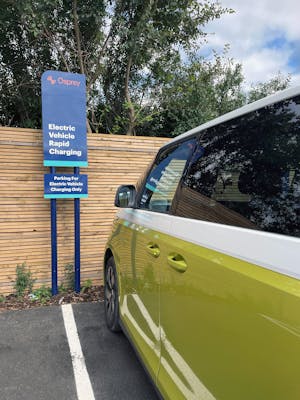How fast can you ACTUALLY charge an electric car?
Unveiling the real world of EV charging speeds.
In the electrifying universe of electric vehicles (EVs), the buzz about faster and more high-powered chargers is in the air. But amidst the hype, the question remains: How fast can you ACTUALLY charge an EV? We are going to explore the ins and outs of EV charging speeds, shedding light on the numbers and providing a real-world perspective on the times you can truly expect even at the highest powered charge points.
Average Charge Rate vs. Peak Charge Rate
As we dive into the world of electric car charging, we often encounter terms like "charge rate". This can be broken down into two distinct categories: Average Charge Rate and Peak Charge Rate. If you're an EV driver, understanding these terms can save you precious time down the road.
Peak Charge Rate is the eye-catching number that car manufacturers advertise, showcasing the lightning-fast speeds at which their EVs can theoretically charge. However, let's look at this closer: this peak rate is sustained for only a very short time during the charging process (which typically follows a "charge curve") and it usually lasts only a few minutes. In essence, the advertised "170kW" may be impressive, but it's just a snapshot of the full charging experience.
Conversely, the Average Charge Rate paints a more accurate picture of the entire charging journey. It factors in the ramp up and ramp down in charging speed as the battery fills up, resulting from the EV's battery management system. This system optimizes battery health by adjusting the charging rate based on temperature and battery state of charge. The EV will not maintain its peak rate throughout the session, so the average rate better reflects the real-world charging rates.
Realistic expectations: balancing speed and convenience
While the quest for faster and more high-powered chargers is often a topic of discussion, the truth is that installing these chargers might not be the game-changer for most vehicles on the road for years to come. The UK's charging infrastructure needs to cater to a wide range of EVs, each with its charging capabilities. Although the allure of high-powered chargers is undeniable, in real life drivers will benefit from more chargers rather than faster chargers (which can be a trade off in public places).
Even EVs with remarkable charging capabilities, like the Kia EV6, don't necessarily reap substantial advantages from ultra-fast chargers. The EV6 boasts a peak charge rate of 233kW and an average charge rate of 200kW, showcasing its prowess. But how fast can it really charge? The real-world contrast becomes apparent when comparing the time it takes to charge from 10% to 80% on a 300kW charger (16 minutes) versus a 150kW charger (22 minutes). The difference? A mere 6 minutes. Two drivers could be charging instead of just one if 2x 150kW charge points were installed rather than one 300kW.
In the world of EV charging, it's important to strike a balance between charging speed and convenience. While some charging sessions may achieve peak speeds for a short duration, focusing on the average charging rate can help set more realistic expectations and serve more drivers. Factors like battery temperature, state of charge, and charging station capabilities can influence the actual time it takes to recharge.
So, how fast can you ACTUALLY charge an electric car? It is important to understand the difference between peak (what is typically advertised) and average charge rates, recognising that average speeds give a much better indication for how long it will take to charge your car.
By considering both your EV's average charge rates and the available charging infrastructure, you can make well-informed decisions about where to stop on that longer journey, and embrace the electric revolution with confidence.
Latest driver resources.
Check out the latest in driver resources from Osprey Charging.





